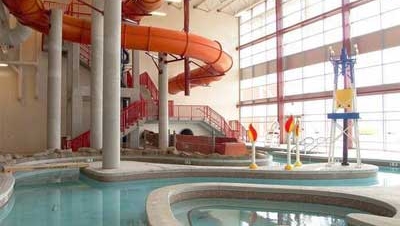Marcissus fell in love with his watery reflection and turned into a flower. Pinocchio escaped the whale but still drowned in the ocean. Jack and Jill tumbled down a hill after fetching a pail.
Adults have certainly written enough of these poignant and tragic tales about the dangers of water for children to get the message: “Don’t go near the water!” But for some years psychologists have been telling us that interaction with water is essential for a child’s development and an entire field of child psychology called Sandplay is based on children using a small table-sized sandbox, representative figures, and water to act out their imaginations. Sure the children create a bit of a mess, but by offering children articles with which to mold and model their worlds, they learn valuable problem-solving skills that can later be applied to real life. Parents seem to be getting the message too. Letting kids interact more frequently with water may be messy, but a little mess may be worthwhile in the long run.
Of course, playground designers who are given the enviable task of providing water-soaked environments may find it easy to open up the nearest supply catalog and pick from a list of great-looking equipment. Such catalogs offer a variety of zero-depth aquatic toys that will fit nicely into a water playground: from water cannons to waterslides, from bucket drops to spray pools, and from splash pads to sprinklers. Any of these items can provide big fun for children who are in the mood to romp and splash.
But remember that such equipment does require more installation and maintenance costs. So select carefully. On the other hand, if you’re a designer looking for cost-conscious ways to incorporate water elements into your designs, ways that may even complement one or two of these larger elements, here are a few suggestions from people who have already taken the plunge.
Vicki L. Stoecklin, a designer with the White and Hutchinson Leisure & Learning Group (www.whitehutchinson.com/children) in Kansas City, Mo., says she has designed recirculating streams, multi-level water tables, spraygrounds and multiple ponds within the same play area. “It need not be expensive, however,” she says, “we talk to people about using dishpans, wading pools, milk gallon jugs, sprinklers, pails of water and hoses.”
Stoecklin also finds that one of the more successful elements has much akin to Sandplay. “We oftentimes use sand and water and put the water source in another location so that children have to transport the water.” Other than the fun children get from making sand forms and the occasional mud pie, how the children develop ways to carry water from place to place also becomes part of the problem-solving process.
Another designer who adds simple water elements to his projects is Ron King with the Natural Playgrounds Co. (www.naturalplaygrounds.com) in Concord, New Hampshire. King’s miniature landscapes often incorporate ponds and streams that are about an inch deep with perforated steel grates that allow the children to walk through the water. Along either edge of the stream, he may place boulders or smaller rocks so that children can hang out and get their feet wet. King has even converted an old macadam parking lot into a play area by cutting channels into the macadam surface to create a system of streams.
After surveying over 3,000 kids about how they play, King admits that the first things they talk about in reference to water play are squirt guns and water balloon fights. But as they keep talking he often finds that they also describe their interest in simple activities, “stepping on rocks in a river, playing on a bridge, playing in the mud.” Since they often want to create their own play areas, King suggests that children be allowed to dig water channels or use wooden planks to divert water and create dams. “They want to know what it’s like out there,” he says. “They want to feel the earth and dig in the sand, and look under a log, and put things together, and be creative in their play choices, and understand what nature is all about.”
If you’re interested in helping children to understand what nature is all about, especially in its aquatic form, few design elements can add more to the site than a rain garden. By installing a few inches of gravel, lying down some fabric, topping this with dirt, and choosing native plant species, you can create a rain garden that filters and cleanses stormwater and pollutants. Rain gardens make sense anywhere, but they can be extremely beneficial in urban areas where designers need to handle drainage from adjacent rooftops or parking lots.
Jan Berg Kruse, a real estate broker and avid gardener in Des Moines, Iowa, found out about rain gardens from personal experience. After witnessing the play area at the local Greenwood Elementary School become cluttered with debris by runoff from a nearby parking lot, she realized that the quality of play for the children was seriously compromised. “I began to see the soil erosion around the school and the mulch and river rock from the play areas was washing onto the grass playfield,” says Berg. “There are 450 students at Greenwood and a limited site for the playground. We needed to improve what we have so there is a place to play during recess.” Determined to do something about the situation, Berg asked her county conservationist and other members of her community for help. The result was a rain garden that provides a buffer between the car and tot lots and takes care of the runoff problem. With an entire ecosystem of plants, insects, and water developing only yards away, the children have the chance to learn about nature as well.
Concerned citizens like Berg and designers like King and Stoecklin should give other playground designers pause for reflection. Using water in the playground can have multiple benefits—from solving local environmental problems to helping children gain an appreciation for nature, and from cutting down on the cost of the playground to providing opportunities for children to engage in creative, developmental play.
It’s true that adults may wish to avoid such situations and stick with more controlled environments, situations where water play happens only when children are well prepared with swimsuits and rain gear. But when designers give parents and clients good reason to think about how much simple water elements can add to the play experience, a pair of muddy hands and a pair of squishy tennis shoes seem like a small price to pay.











Add new comment